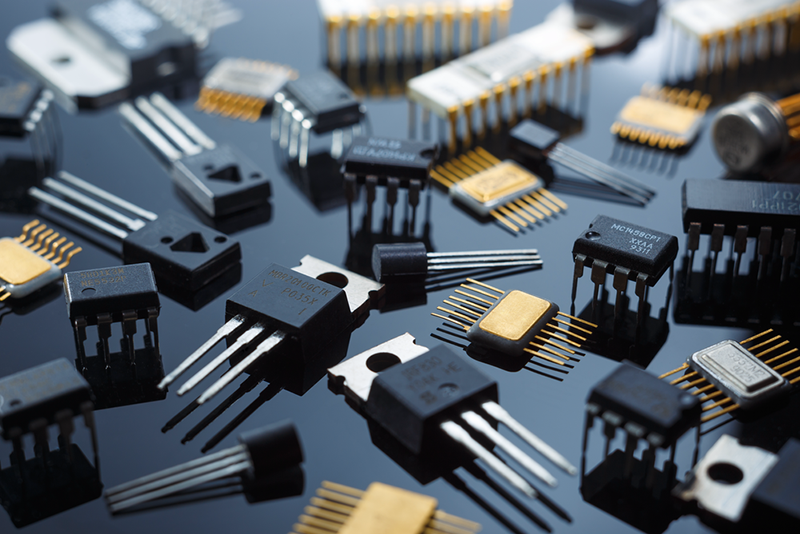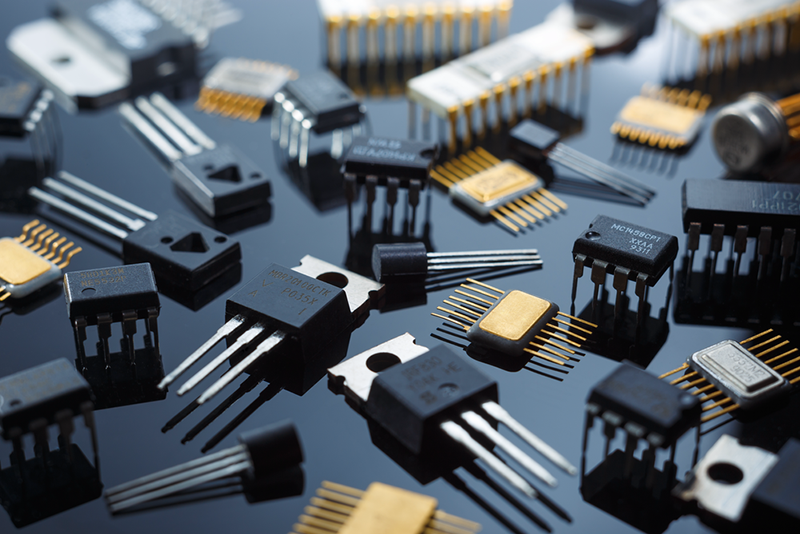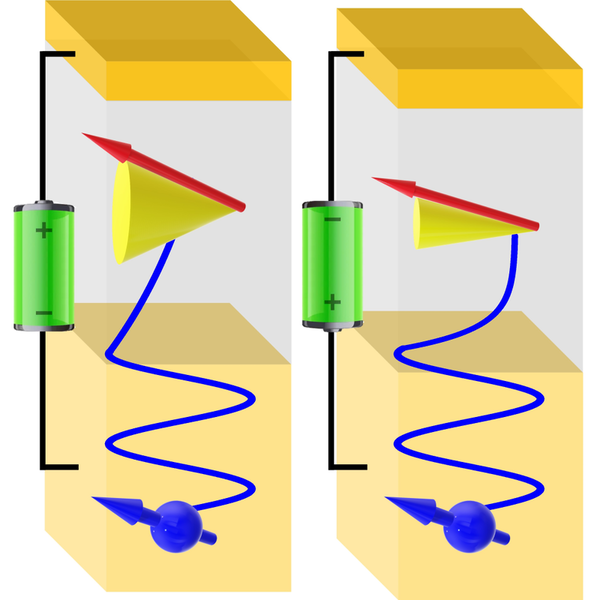Voltage Control over Magnons
Magnonic devices are being developed to transmit signals, not with electrons, but with magnons—traveling waves in the magnetic ordering of a material. New work provides one of the missing elements of the magnonics toolbox: a voltage-controlled magnon transistor [1]. The device is made up of a magnetic insulator sandwiched between two metal plates. The researchers show that they can control the flow of magnons in the insulator through voltages applied to the plates. The results could lead to more-efficient magnonic devices.
A magnon can be imagined as a row of fixed magnetic elements, or “spins,” that tilt and rotate their orientations in a coordinated pattern. This “spin wave” can carry information through a material without involving the movement of charges, which can cause undesirable heating in a circuit. Magnonics—though still in its infancy—is a potentially energy-efficient alternative to traditional electronics, says Xiu-Feng Han from the Chinese Academy of Sciences. The challenge right now for the magnonics field, he says, is developing practical versions of the four basic components of a magnonic circuit: a generator, a detector, a switch, and a transistor.
A normal transistor—as found in a radio, a phone, or any other electronic device—has a control knob (typically an input voltage) that regulates an outflow of current. Magnon transistors, which regulate a flow of magnons, have been demonstrated previously (see Focus: A Trio of Magnon Transistors), but they have been energy inefficient, Han says, as their control mechanism has been either a magnetic field or an electric current. He and his colleagues have now constructed a more efficient transistor in which the magnons are controlled by a voltage.
The transistor consists of a thick layer of yttrium iron garnet (YIG), a magnetic insulator, with thin layers of platinum above and below. The researchers drive a current through the bottom platinum layer, generating a current of spin-aligned electrons that flows upward in the bottom plate toward the YIG. An effect called magnon-mediated electric current drag (MECD) causes the upward-moving spin current in the platinum to convert into a stream of upward-moving magnons in the YIG (see Viewpoint: Putting a New Spin on Heat Flow).
To control the flow of magnons through the YIG, the team applied a voltage between the two platinum layers. This voltage alters the MECD effect: with the upper plate positive (+2 V), the flow of magnons increased by 5%, whereas reversing the voltage (−2 V) decreased the magnon flow by roughly the same amount. The team did not measure the magnons directly, but instead measured the output voltage that the magnons generated in the perpendicular direction in the top platinum layer through the reverse MECD effect. The team estimated the heating loss as being around 20 nanowatts for an applied voltage of 2 V. By comparison, a current-driven magnon transistor would have 100 times greater loss for the same 5% change in magnon flow.
The team has plans to go further. “We are aiming to construct magnonic circuits with some computing or memory functionality in the near future,” Han says. One possibility would be to replace the top platinum layer with a magnet layer. The magnons flowing through the YIG could be used to set the magnetization in the top layer, perhaps as a way to store information.
Shufeng Zhang, a condensed-matter theorist from the University of Arizona, says that the primary novelty of this work is the revelation that a voltage can significantly alter the MECD effect in a magnetic insulator layer. “This voltage response is somewhat surprising given the traditionally minimal coupling between electric fields and magnons,” Zhang says. He thinks the work could help elucidate various properties of magnon transport. But he says that the immediate applicability for transistors may be limited, as the output voltage of a few microvolts is 100,000 times less than that of conventional silicon-based transistors. Han agrees that the low voltage is a limitation, but he says that optimization steps—such as choosing materials that produce a stronger initial spin current or using single crystal nanostructures that give a higher spin-magnon conversion efficiency—could boost the output voltage.
–Michael Schirber
Michael Schirber is a Corresponding Editor for Physics Magazine based in Lyon, France.
References
- Y. Z. Wang et al., “Voltage-controlled magnon transistor via tuning interfacial exchange coupling,” Phys. Rev. Lett. 132, 076701 (2024).






